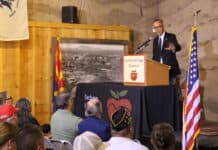It appears that we are on the back end of the two major wildfires burning in the Verde Valley.
The Rafael Fire, burning on top of the Colorado Plateau is largely contained on its northern and eastern perimeters, with the fire spreading slowly west into Sycamore Canyon. It has burned 78,708 acres as of Tuesday, June 29, making it the largest fire to affect the Verde Valley.
[EDITOR’S NOTE: The final size of the fire was recalcuated at 78,065 acres on Friday, July 2]
Fire managers wanted to push the fire in this direction because it was moving in that direction unabated anyway and, according to the experts, fires that start at the top of a rim and burn down into a canyon do less damage to the soil than those that start at the bottom and burn their way up.
The 21,227-acre Slide Fire in Oak Creek Canyon did both in 2014, and the fire that climbed up at the south end damaged more terrain than the fire that came down into West Fork, which has largely recovered. Part of the reason the Rafael Fire slowed on its eastern front was that it reached the western frontier of the Slide Fire, meaning there were fewer fire fuels to burn.
This weekend, photojournalist David Jolkovski was invited to tour the Rafael Fire perimeter. We have posted photos on our website, redrocknews. com, and published a photo spread on Page 6A. We would like to sincerely thank the fire managers and the firefighters, especially the Mormon Lake Hotshots, who allowed Jolkovski to tag along to get our readers photos to show them what the forest looks like on the front lines.
That said, the blaze is contained enough that yesterday, Monday, June 28, the Rafael Fire management team announced they would stop doing morning media because of diminishing interest, which they acknowledged is a good thing.
On the other side of the Verde Valley, the Backbone Fire started on June 16, two days before the Rafael.
It reached 40,855 acres as of Tuesday, June 29, and sort of met its own natural perimeter. It has only slowly been growing larger.
Rains in the Camp Verde area were heavier than in the Sedona area last week, which journalist Mikayla Blair reported in our sister newspapers had slowed, but not necessarily stopped, that fire.
The Rafael Fire’s large smoke plume could be seen all over the Verde Valley, but the flames could only be seen out on State Route 89A or from the Forest Road 525 and Bill Gray Road area. Conversely, the Backbone Fire can easily be seen burning from the Verde Lakes neighborhood of Camp Verde on Wingfield Plateau, day and night, as flames char the Towel Peaks and Cimarron Hills, slowly coming down into the Cottonwood Basin.
Forecasters expect rain in the next few days and weeks, which should prevent these massive wildfires from replicating elsewhere.
As we move into the monsoon, which is expected to be normal or slightly above normal, wet weather will likely reduce the burnability of fire fuels and make fires that do start easier to fight. With the right confluence of monsoon storms, Northern Arizona may be able to lift the full closures in the Coconino, Prescott, Kaibab and Apache-Sitgreaves National Forests by mid July, but weather is a fickle monster.
Weather experts say we are still in a massive drought, but it’s hard to really know what that means anymore. The Southwest in general and Arizona specifically have been in a drought my entire adult life, so we must wonder when temporary becomes permanent and if this is just the way things are now.
Christopher Fox Graham
Managing Editor



















